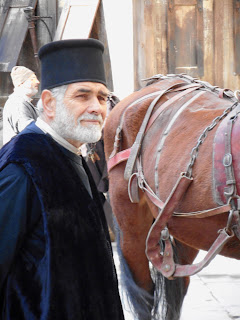Venezia is everything it's reputed to be...
...beautiful...
...decadent...
...romantic...
...and a fascinating playground for history buffs.
On most days, the tourists outnumber the residents.

In many ways, not much in Venezia has changed since the 1700's...when it was considered the most sophisticated city in Europe.
The Canal Grande now has power boats in addition to gondolas plying its waters, but the buildings that line the canal look much the same as they did 300 years ago.
Venezia was once Europe's largest city. How did that get to be..and what's happened since?
Venezia first became a city when the barbarians toppled the Roman Empire, and thousands fled to the islands in the Venetian lagoon for safety. In 726, it separated from the remnants of the Roman Empire, established itself as "The Serene Republic of Venice," and elected its first Doge (duke in Venetian dialect).
In the 900's, it competed with Genoa, Pisa, and Amalfi to become the dominant trade center of the Mediterranean. By 1200, it had succeeded enough that this man...
Marco Polo...expanded Venezia's trade partnerships by opening overland trade routes with the Orient.
Marco Polo was not the first Venetian to travel to China, but he became a very successful merchant. His book about his travels was a best-seller in the days before the printing press.
His house was located here...in the Milion neighborhood...so named because of the wealth his and the other trading houses brought to Venezia.
By this time, the Serene Republic had become a potent political force. It had wiped out the Dalmatian pirates, set up vassal states in Split and Dubrovnik, and conquered Crete, Cyprus, and the Greek islands.
While the other city-states in Italy were scheming and jockeying among themselves for power, Venezia had its attentions turned outwards.
For centuries, it dominated the Adriatic, the Balkans, and relations with Constantinople.
Venetian interest in the Byzantine East is commonly reflected in its architecture...
...including the Doge's Palace, the seat of government during the 900 years of the Venetian Republic.
The Doge's Palace was built in 1172 but damaged by fire on two occasions.
The second fire, in 1577, forced the complete renovation of the interior and gave Titian, Tintoretto, and Veronese among other artists a life-time of work.
At this point, Venezia was the largest and wealthiest city in Europe.
The city displayed its wealth in its public places with a show of opulence never before seen in the West.
The Hall of the Great Council was, at the time, the largest room ever built...quite an engineering as well as artistic achievement.
The walls of the Hall recount Venezia's military successes...like this Tintoretto depicting the battle of Zara...
...where the Venetians defeated the Hungarian Army and preserved Croatia as a vassal state.
Or, this detail from the Battle of Leponto, where the Venetian Navy defeated the Ottoman Turks, to gain dominance of Mediterranean sea lanes.

Just below the ceiling of the Great Hall are portraits of all the Doges who ruled Venezia...save one.
Marina Falter tried to overthrow the government of the Republic...and failed. He was disgraced and publicly executed. As a final indignity, his portrait was blacked out in the Great Hall.
All the things that led to Venezia's success eventually sowed the seeds of its demise. The Ottoman Turks conquered the Balkans. Venetian traders returning from Asia brought the Black Death with them...killing off one-third of Venezia's population not once but on four different occasions. Finally, Portuguese and Dutch traders, inspired by Marco Polo, proved sea trade with the East was more efficient than overland travel.


By the mid-1700's, Venezia remained a trend-setter in fashions, but its dominance in trade with the Orient had waned.
In 1797, Venezia lost its independence when Napoleon conquered Italy. After Napoleon's defeat, it was annexed to the Austrian Empire.
Today, the city has declined to a state of what critics call "elegant decadence."
Its population is one-tenth what it was at the height of its power.
The baroque interior of San Marco cathedral... once the Doge's private chapel... is still jaw-dropping but glitters a bit less than it did in its heyday.
A close look at any building shows the effects centuries of decline and weathering have had.
The city is slowly sinking into the lagoon.
As the buildings settle over the centuries, the bell towers of many of the 139 churches list to one side...proving once again that Pisa is not Italy's only city with a leaning tower.
The narrow canals that run through the city turn its calle into dead-end labyrinths that even a good map can't help a tourist navigate.
Even the occasional motor launch put-putting down a canal barely interrupts the quiet you get with a car-free city.
For the even slightly-adventurous, wandering down the narrow calle provides a great way to get lost...
...and to stumble upon an unexpected treasure.
For years, we have been telling our friends about our favorite detective series...Donna Leon's Commasario Brunetti mysteries.
We therefore couldn't resist a visit to the Palazzo Falier...where, in the novels, Brunetti's in-laws live.
The palazzo is real, though it's not actually the elegant home of the fictitous conte and contessa Falier...who never fail to provide insights into the lives of Venezia's wealthy elite.
 |
| The winged lion...the symbol of Venezia |































































